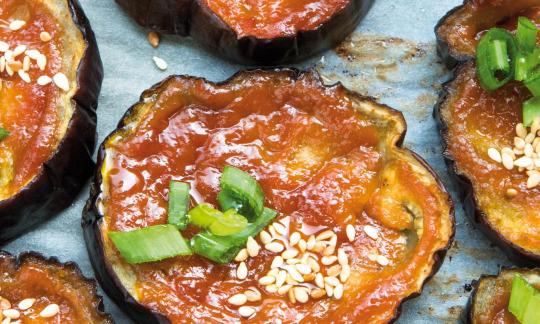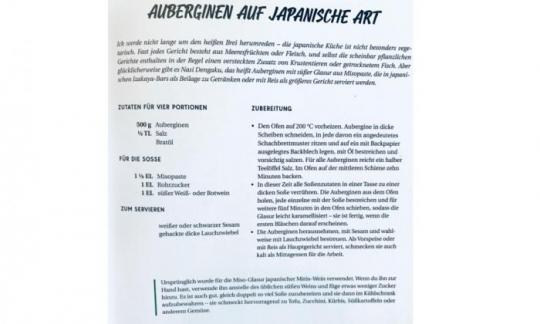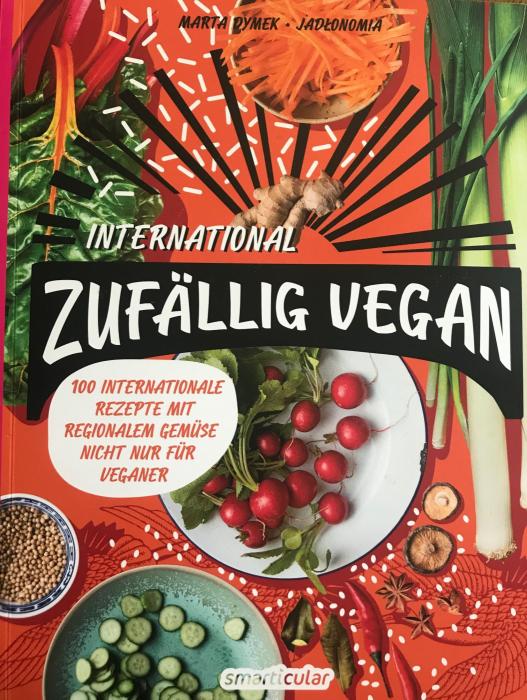Japanese-style eggplant with miso paste
vegan
Ingredients (for servings, )
| 18 oz | Eggplant, raw (organic?) |
| ¼ tsp | Table salt (table salt, raw?, organic?) (0.05 oz) |
| 2 tbsp | Rapeseed oil, refined (organic?) (0.98 oz) |
| For the sauce | |
|---|---|
| 1 ½ tbsp | Miso (soybean paste) (0.90 oz) |
| 1 tbsp | Brown sugar (raw sugar, whole cane sugar, whole sugar, organic?) (0.32 oz) |
| 1 tbsp | Port wine (raw?, organic?) (0.52 oz) |
| To serve | |
| 1 tbsp | Sesame, black (raw, organic?) (0.32 oz) |
| 2 | Spring onions, stems and leaves only (raw, organic?) (1.7 oz) |
Equipment
- oven
- baking sheet (cookie sheet)
Type of preparation
- bake
- chop or grind
- caramelize
Preparation
Preparing eggplants
Preheat the oven to 200°C. Cut the eggplants into thick slices, make a checkerboard pattern in each one and place on a baking tray lined with baking paper, brush with oil and carefully sprinkle with salt. Bake in the oven on the middle rack for ten minutes. In the meantime, continue with step 2.We have reduced the salt content by half (see "Alternative preparation").
For the sauce
Mix all sauce ingredients (miso, cane sugar and wine) in a cup to form a thick sauce.In the recipe, the author specifies mirin wine (rice wine) or sweet white or red wine.
Remove the eggplants from the oven, brush each one with the sauce and put them back in the oven for another five minutes so that the glaze caramelizes slightly - it is ready when the first bubbles appear on it.
Arrange and serve
Remove the eggplants and sprinkle with sesame seeds and optionally with spring onions. Serve as a starter or with rice as a main course. They also taste good cold for lunch.You can also use white sesame seeds instead of black.
|
Nutritional Information per person
Convert per 100g
|
2000 kcal | |
|---|---|---|
| Energy | 137 kcal | 6.9% |
| Fat/Lipids | 8.8 g | 12.5% |
| Saturated Fats | 0.77 g | 3.9% |
| Carbohydrates (inc.dietary fiber) | 13 g | 4.8% |
| Sugars | 7.9 g | 8.8% |
| Fiber | 4.6 g | 18.3% |
| Protein/Albumin | 2.6 g | 5.1% |
| Cooking Salt (Na:388.7 mg) | 987 mg | 41.1% |
| Essential micronutrients with the highest proportions | per person | 2000 kcal | |
|---|---|---|---|
| Min | Copper, Cu | 0.60 mg | 60.0% |
| Sodium, Na | 389 mg | 49.0% | |
| Vit | Vitamin K | 34 µg | 45.0% |
| Fat | Alpha-Linolenic acid; ALA; 18:3 omega-3 | 0.70 g | 35.0% |
| Vit | Vitamin E, as a-TEs | 2.7 mg | 23.0% |
| Min | Manganese, Mn | 0.42 mg | 21.0% |
| Fat | Linoleic acid; LA; 18:2 omega-6 | 2.0 g | 20.0% |
| Elem | Potassium, K | 336 mg | 17.0% |
| Vit | Vitamin B9, B11 (Folate, as the active form of folic acid) | 35 µg | 17.0% |
| Prot | Tryptophan (Trp, W) | 0.03 g | 12.0% |
Detailed Nutritional Information per Person for this Recipe
The majority of the nutritional information comes from the USDA (US Department of Agriculture). This means that the information for natural products is often incomplete or only given within broader categories, whereas in most cases products made from these have more complete information displayed.
If we take flaxseed, for example, the important essential amino acid ALA (omega-3) is only included in an overarching category whereas for flaxseed oil ALA is listed specifically. In time, we will be able to change this, but it will require a lot of work. An “i” appears behind ingredients that have been adjusted and an explanation appears when you hover over this symbol.
For Erb Muesli, the original calculations resulted in 48 % of the daily requirement of ALA — but with the correction, we see that the muesli actually covers >100 % of the necessary recommendation for the omega-3 fatty acid ALA. Our goal is to eventually be able to compare the nutritional value of our recipes with those that are used in conventional western lifestyles.
| Essential fatty acids | per person | 2000 kcal |
|---|---|---|
| Alpha-Linolenic acid; ALA; 18:3 omega-3 | 0.70 g | 35.0% |
| Linoleic acid; LA; 18:2 omega-6 | 2.0 g | 20.0% |
| Essential amino acids | per person | 2000 kcal |
|---|---|---|
| Tryptophan (Trp, W) | 0.03 g | 12.0% |
| Threonine (Thr, T, irreversibly transaminated) | 0.09 g | 10.0% |
| Isoleucine (Ile, I) | 0.11 g | 9.0% |
| Valin (Val, V) | 0.12 g | 8.0% |
| Leucine (Leu, L) | 0.16 g | 7.0% |
| Phenylalanine (Phe, F) | 0.11 g | 7.0% |
| Lysine (Lys, K, irreversibly transaminated) | 0.10 g | 5.0% |
| Methionine (Met, M) | 0.04 g | 4.0% |
| Vitamins | per person | 2000 kcal |
|---|---|---|
| Vitamin K | 34 µg | 45.0% |
| Vitamin E, as a-TEs | 2.7 mg | 23.0% |
| Vitamin B9, B11 (Folate, as the active form of folic acid) | 35 µg | 17.0% |
| Vitamin B6 (pyridoxine) | 0.15 mg | 11.0% |
| Vitamin B1 (Thiamine) | 0.08 mg | 7.0% |
| Vitamin B5 (Pantothenic acid) | 0.39 mg | 7.0% |
| Vitamin C (ascorbic acid) | 4.4 mg | 6.0% |
| Vitamin B3 (Niacin) | 1.0 mg | 6.0% |
| Vitamin A, as RAE | 46 µg | 6.0% |
| Vitamin B2 (Riboflavin) | 0.07 mg | 5.0% |
| Vitamin B12 (Cobalamin) | 0.00 µg | < 0.1% |
| Vitamin B7 (Biotin, ex vitamin H) | 0.02 µg | < 0.1% |
| Essential macroelements (macronutrients) | per person | 2000 kcal |
|---|---|---|
| Sodium, Na | 389 mg | 49.0% |
| Potassium, K | 336 mg | 17.0% |
| Magnesium, Mg | 31 mg | 8.0% |
| Phosphorus, P | 58 mg | 8.0% |
| Calcium, Ca | 45 mg | 6.0% |
| Essential trace elements (micronutrients) | per person | 2000 kcal |
|---|---|---|
| Copper, Cu | 0.60 mg | 60.0% |
| Manganese, Mn | 0.42 mg | 21.0% |
| Iron, Fe | 0.88 mg | 6.0% |
| Zinc, Zn | 0.58 mg | 6.0% |
| Selenium, Se | 1.7 µg | 3.0% |
| Fluorine, F | 0.01 µg | < 0.1% |
| Iod, I (Jod, J) | 0.37 µg | < 0.1% |
Randomly Vegan International: 100 international recipes with regional vegetables – not just for vegans. Unusual yet easy-to-prepare dishes.
Since this book is written in German, a description is omitted here. If you are interested, please switch to German in the menu.
Japanese-style eggplant with miso paste is enjoyed as a side dish with drinks or rice.
Marta Dymek: This dish is called Nasi Dengaku in Japanese and means eggplant with a sweet glaze made from miso paste. It is served in Japanese Izakaya bars.
Nutrient profile: According to GDA guidelines, one portion of this recipe covers more than 25% of the daily requirement of copper, manganese and omega-3 fatty acids. The ratio of omega-6 to omega-3 fatty acids is 4:1, within the recommended maximum ratio of 5:1.
You can find more information behind this motivation at the following link: Vegans often eat unhealthily. Avoidable nutritional errors.
Eggplant: There are several types that differ in shape and color. The most common varieties sold in Europe and North America are elongated and have a dark purple color. The raw fruit has a slightly bitter taste with a somewhat astringent quality. When cooked, however, it acquires a tender consistency and develops a rich and complex flavor.
Sesame: Sesame is an annual, herbaceous plant species. Originally native to certain parts of India and Africa, this cultivated and oil plant is now grown in tropical and subtropical regions around the world. The sesame cultivated there comes from wild plants from South Asia, which have been archaeologically documented as far back as the third millennium BC. The seeds, oil and roots of sesame can be used for therapeutic and culinary purposes. Depending on the variety, the fruit capsules contain black, brown or white seeds, with black sesame seeds being considered to have a more aromatic taste than white sesame seeds. The high calcium and selenium content of sesame seeds is particularly noteworthy.
Miso: Miso is a Japanese paste made mainly from soybeans with varying amounts of rice, barley or other grains. Miso is a natural flavor enhancer that tastes like fermented beans and can range from spicy to sweet.
Marta Dymek: It's a good idea to make twice as much sauce and then store it in the fridge - it tastes great with tofu, zucchini, pumpkin, sweet potatoes or other vegetables.
Frying oil: We chose refined rapeseed oil as our frying oil. Rapeseed oil has a high proportion of essential fatty acids, especially omega-3 fatty acids.
Salt: We have deliberately halved the amount of salt, as miso itself contains a lot of salt. The aim is to keep the salt content as low as possible without compromising on taste. As salt requirements vary from person to person, it is best for you to decide for yourself. We would like to recommend the book " Salt, Sugar, Fat " as an interesting read on this topic.
Marta Dymek: Originally, Japanese mirin wine was used for the miso glaze. If you have it on hand, use it instead of port or sweet wine and add a little less sugar.






